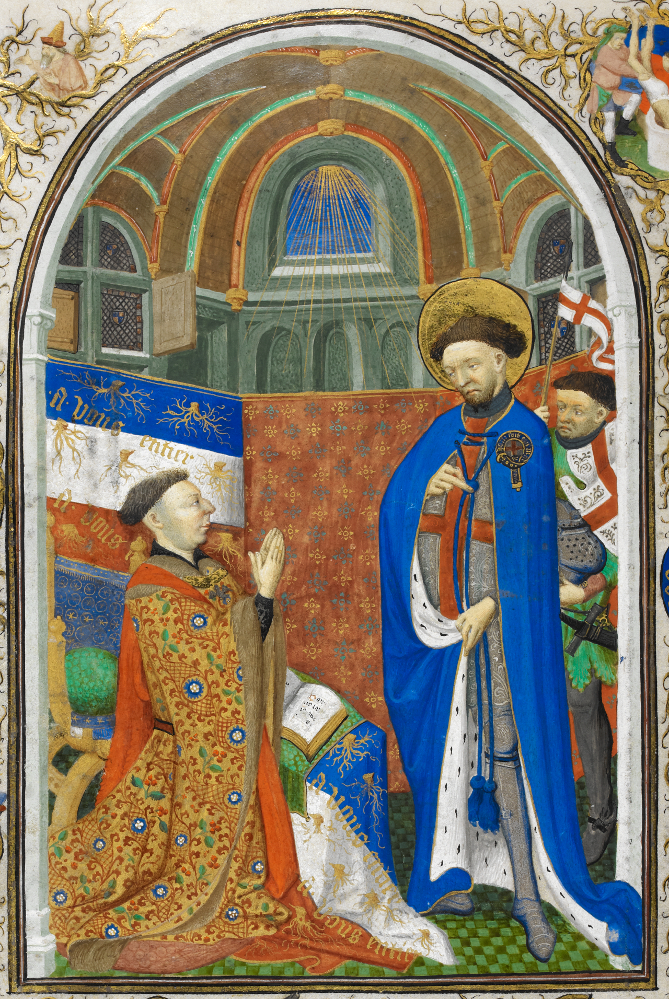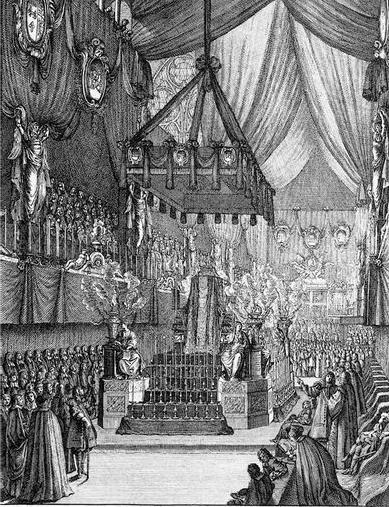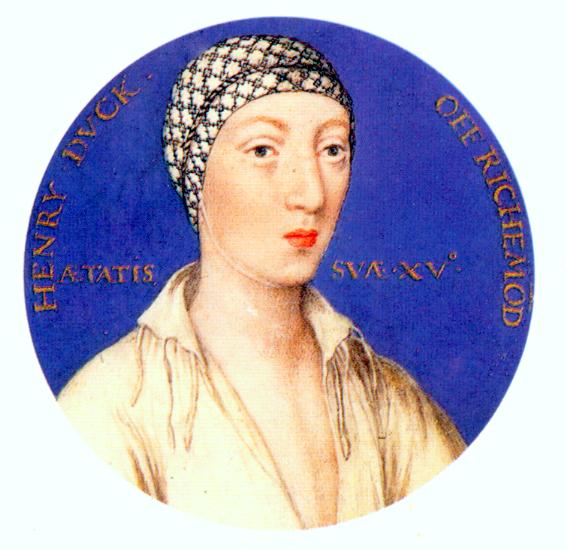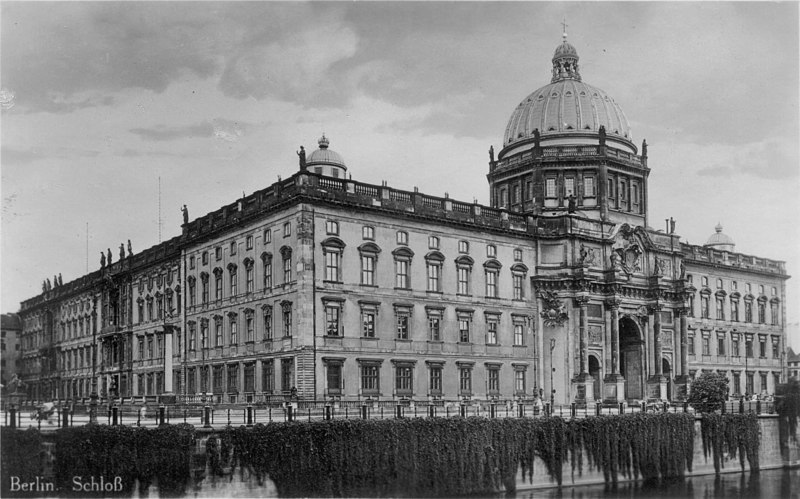by Scott Mehl
© Unofficial Royalty 2013
Revised and Expanded 2023

The Coronation Ceremony of His Most Gracious Majesty King George V in Westminster Abbey. 22nd June 1911
© National Portrait Gallery, London (used with permission)
Check out all our British coronation articles at the link below:
King George V became Sovereign upon the death of his father, King Edward VII, on May 6, 1910. The following year, on June 22, 1911, King George V and his consort, Queen Mary, were crowned at Westminster Abbey. The guests were all in place by 8:30 am although the service did not begin until 11: am. At 10:30, King George V and Queen Mary left Buckingham Palace in the Gold State Coach, in a grand procession to Westminster Abbey. Following the traditional Coronation ceremony, including the homage of their eldest son, The Prince of Wales (later King Edward VIII, and Duke of Windsor), the newly crowned King and Queen returned to Buckingham Palace, where they appeared on the balcony several times throughout the day.
Peers and peeresses arrive at Westminster Abbey for the coronation of King George V and Queen Mary. All peers and peeresses were invited along with all Members of Parliament.
King George V and Queen Mary’s eldest son The Prince of Wales (later King Edward VIII and The Duke of Windsor) and their only daughter Princess Mary (later The Princess Royal) in their coronation garb.
King Georg V and Queen Mary’s coronation was one of the last great gatherings of royalty before World War I. Many of the foreign royals listed below are from monarchies that ceased to exist in the aftermath of World War I or later during the 20th century. Among the 6,000 guests at the coronation service were:
British Royal Family
- The Prince of Wales, the King and Queen’s son
- Prince Albert, the King and Queen’s son
- Princess Mary, the King and Queen’s daughter
- Prince Henry, the King and Queen’s son
- Prince George, the King and Queen’s son
- Princess Louise, The Princess Royal and Alexander Duff, 1st Duke of Fife, the King’s sister and brother-in-law
- Princess Alexandra, the King’s niece
- Princess Maud, the King’s niece
- The Duchess of Saxe-Coburg and Gotha, The Duchess of Edinburgh (born Grand Duchess Maria Alexandrovna of Russia), the King’s paternal aunt by marriage
- Crown Princess Marie (born Princess Marie of Edinburgh) and Crown Prince Ferdinand of Romania, the King’s first cousin and the King’s third cousin, representing his uncle King Carol I of the Romania
- Princess Helena, Princess Christian of Schleswig-Holstein and Prince Christian of Schleswig-Holstein, the King’s paternal aunt and uncle
- Prince Albert of Schleswig-Holstein, the King’s first cousin
- Princess Helena Victoria of Schleswig-Holstein, the King’s first cousin
- Princess Marie Louise of Schleswig-Holstein, the King’s first cousin
- Princess Louise, The Duchess of Argyll and John Douglas Sutherland Campbell, 9th Duke of Argyll, the King’s paternal aunt and uncle
- Prince Arthur, The Duke of Connaught and The Duchess of Connaught (born Princess Louise Margaret of Prussia), the King’s paternal uncle and aunt
- Crown Princess Margaret (born Princess Margaret of Connaught) and Crown Prince Gustaf Adolf of Sweden, the King’s first cousin and her husband, the King’s third cousin (representing his father King Gustaf V of Sweden)
- Prince Arthur of Connaught, the King’s first cousin
- Princess Patricia of Connaught, the King’s first cousin
- The Dowager Duchess of Albany (born Princess Helena of Waldeck and Pyrmont), the King’s paternal aunt by marriage
- Princess Alice of Albany, Princess Alexander of Teck and Prince Alexander of Teck, the King’s first cousin and the Queen’s brother
- Prince Charles Edward, The Duke Saxe-Coburg and Gotha and The Duchess of Saxe-Coburg and Gotha (born Princess Victoria Adelaide of Schleswig-Holstein) – also Duke and Duchess of Albany – the King’s first cousin and the King’s second cousin
- Princess Beatrice, Princess Henry of Battenberg, the King’s paternal aunt
- Prince Alexander of Battenberg, the King’s first cousin
- Prince Leopold of Battenberg, the King’s first cousin
- Prince Maurice of Battenberg, the King’s first cousin
- Princess Louis of Battenberg (born Princess Victoria of Hesse and by Rhine) and Prince Louis of Battenberg, the King’s first cousin and her husband
- Princess Louise of Battenberg, the King’s first cousin once removed
- Prince George of Battenberg, the King’s first cousin once removed
- The Duke of Teck and The Duchess of Teck (born Lady Margaret Evelyn Grosvenor), the Queen’s brother and sister-in-law
- Prince George of Teck, the Queen’s nephew
- Princess Mary of Teck, the Queen’s niece
- Princess Helena of Teck, the Queen’s niece
- Princess Victor of Hohenlohe-Langenburg (born Laura Williamina Seymour), widow of the King’s half-first cousin once removed
- Countess Feodora Gleichen, the King’s half-second cousin
- Count Edward Gleichen, the King’s half-second cousin
- Countess Valda Machel, the King’s half-second cousin
- Countess Helena Gleichen, the King’s half-second cousin
- Aubrey FitzClarence, 4th Earl of Munster, the King’s third cousin
- Charles FitzClarence, the King’s third cousin
Foreign Royalty
- Crown Prince Wilhelm of Prussia and Crown Princess Cecilie of Prussia (born Cecilie of Mecklenburg-Schwerin), the King’s first cousin once removed and his wife, his father Wilhelm II, German Emperor and King of Prussia
- The Hereditary Princess of Saxe-Meiningen (born Princess Charlotte of Prussia), the King’s first cousin, representing her father-in-law Georg II, Duke of Saxe-Meiningen
- Prince Heinrich of Prussia, the King’s first cousin
- The Hereditary Princess of Hesse (born Princess Margarete of Prussia) and Hereditary Prince Friedrich Karl of Hesse, the King’s first cousin and her husband
- Grand Duke Ernst Ludwig of Hesse and by Rhine and Grand Duchess of Hesse and by Rhine (born Princess Eleanore of Solms-Hohensolms-Lich), the King’s first cousin and his wife
- Crown Prince Christian of Denmark, the King’s first cousin, representing his father King Frederik VIII of Denmark
- Crown Prince Constantine of Greece and Crown Princess Sophie of Greece (born Princess Sophie of Prussia), the King’s first cousins, representing his father King George I of Greece
- Prince George of Greece and Denmark, the King’s double first cousin once removed
- Prince George of Greece and Denmark and Princess George of Greece and Denmark (born Princess Maria Bonaparte), the King’s first cousin and his wife
- Princess Maximilian of Baden (born Princess Marie Louise of Hanover) and Prince Maximilian of Baden, the King’s first cousin and her husband, representing Grand Duke Friedrich II of Baden
- Alexandra of Hanover and Cumberland, Grand Duchess of Mecklenburg-Schwerin and Grand Duke Friedrich Franz IV of Mecklenburg-Schwerin, the King’s first cousin and her husband
- Prince Ernest Augustus of Hanover and Cumberland, the King’s first cousin
- Grand Duke Adolf Friedrich V of Mecklenburg-Strelitz, the Queen’s first cousin
- Crown Jutta Princess (born Duchess Jutta of Mecklenburg-Strelitz) and Crown Prince Danilo of Montenegro, the Queen’s first cousin once removed and her husband, representing King Nicholas of Montenegro)
- Hereditary Grand Duke Adolph Friedrich of Mecklenburg-Strelitz, the Queen’s first cousin once removed
- Prince Philipp of Saxe-Coburg and Gotha, the King’s second cousin once removed
- Prince Leopold Clement of Saxe-Coburg and Gotha, the King’s third cousin
- Ernst Gunther, Duke of Schleswig-Holstein, the King’s third cousin
- Prince Boris of Bulgaria, The Prince of Tarnovo, the King’s third cousin, representing his father Tsar Ferdinand I of Bulgaria
- Duke Albrecht of Württemberg, the King’s third cousin, representing King Wilhelm II of Württemberg
- Crown Prince Yusuf Izzeddin Efendi of the Ottoman Empire, representing the Ottoman Sultan Mehmed V
- Archduke Karl of Austria, representing Emperor Franz Joseph I of Austria
- The Duke of Aosta and The Duchess of Aosta (born Princess Hélène of Orléans), representing his cousin King Vittorio Emanuele III of Italy
- Grand Duke Boris Vladimirovich of Russia representing his first cousin Nicholas II, Emperor of All of Russia, first cousin of the King
- Infante Ferdinand of Spain, representing King Alfonso XIII of Spain
- Prince Higashifushimi Yorihito and Princess Higashifushimi of Japan, representing Emperor Meiji of Japan
- Crown Prince Alexander of Serbia, representing his father King Peter I of Serbia
- Prince Chakrabongse Bhuvanath of Siam, representing King Vajiravudh of Siam
- Prince Rupprecht of Bavaria, representing Luitpold, Prince Regent of Bavaria
- Prince Johann Georg of Saxony and Princess Johann Georg of Saxony (born Princess Maria Immacolata of Bourbon-Two Sicilies), representing his brother King Friedrich August III of Saxony
- Prince Hendrik of the Netherlands (born Duke Heinrich of Mecklenburg-Schwerin), representing his wife Queen Wilhelmina of the Netherlands
- Prince Zaizhen of China, representing the Emperor Puyi of China
- Prince Kassa Haile Darge of Ethiopia, representing Emperor Menelik II of Ethiopia
- Prince Mohammed Ali Tewfik of Egypt , representing the Khedive Abbas II of Egypt
- Hereditary Prince Louis of Monaco, representing Prince Albert I of Monaco
- Madho Rao Scindia, Maharaja of Gwalior
- Pratap Singh, Maharaja of Idar
- Ganga Singh, Maharaja of Bikaner
A photo taken on June 20, 1911, two days before the coronation, shows the Coronation Chair in front of the high altar at Westminster Abbey
Westminster Abbey, the site of English and British coronations going back to 1066, had closed a month earlier to prepare for the event. In order to accommodate the 6,000 invited guests, the fixed pews were removed and Chippendale-style chairs were put in place, each carved with a royal coronet and inscribed with the guest’s name. Afterward, the guests were given the opportunity to purchase the chairs as souvenirs. A brilliant new carpet was designed and installed, and a special annex was built to serve as the robing room for the King and Queen.
Read more at these links:
Over 50,000 troops took part in the festivities, marching in the procession and lining the route. Special camps were set up around London to accommodate them – in Hyde Park and Kensington Park for the British troops, in Alexandra Park for the Dominion troops, and in Hampton Court Palace for the Indian troops.
King George V re-established the tradition of being crowned with St. Edward’s Crown, last used for King William III at the coronation of King William III and his wife and co-ruler Queen Mary II in 1689. St. Edward’s Crown was only used for the actual crowning part of the Coronation ceremony, after which the King wore the Imperial State Crown, created for Queen Victoria’s coronation in 1838 and also used for King Edward VII’s coronation in 1902.) This is the crown he is wearing in the photograph above.

Queen Mary’s Crown as it looked in 1911; Credit – Wikipedia
In keeping with the tradition started by Queen Adelaide in 1831, a new crown was created for Queen Mary, containing the Koh-i-Noor diamond and the Cullinan III and Cullinan IV diamonds. Previous Queen Consorts used the Crown of Mary of Modena. Queen Mary’s new crown was designed with eight arches, which were removable so that it could be worn as a circlet. This is how Queen Mary later wore it to the coronation of her son, King George VI, in 1937. The Koh-i-Noor diamond was transferred to the Crown of Queen Elizabeth The Queen Mother in 1937 for her coronation, and it will remain in that crown. Queen Camilla was crowned using Queen Mary’s Crown on May 6, 2023. Modifications included re-setting the crown with the original Cullinan III and IV diamonds, and additionally the Cullinan V diamond, and removing four of its eight half-arches.
A brief extract from the diary of King George V on the day of the Coronation:
“The Service in the Abby was most beautiful and impressive, but it was a terrible ordeal. IT was grand, yet simple & most dignified & went without a hitch. I nearly broke down when dear David came to do homage to me, as it reminded me so much when I did the same thing to beloved Papa, he did it so well. Darling May looked lovely & it was indeed a comfort to have her by my side as she has been ever to me during these last 18 years.”
This article is the intellectual property of Unofficial Royalty and is NOT TO BE COPIED, EDITED, OR POSTED IN ANY FORM ON ANOTHER WEBSITE under any circumstances. It is permissible to use a link that directs to Unofficial Royalty.

























